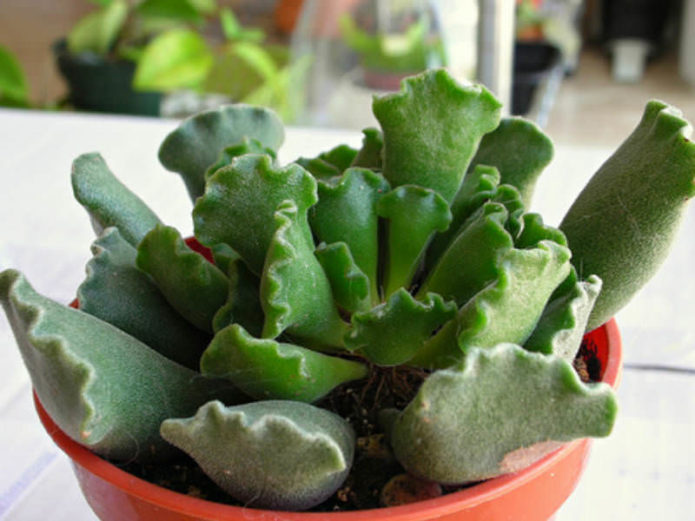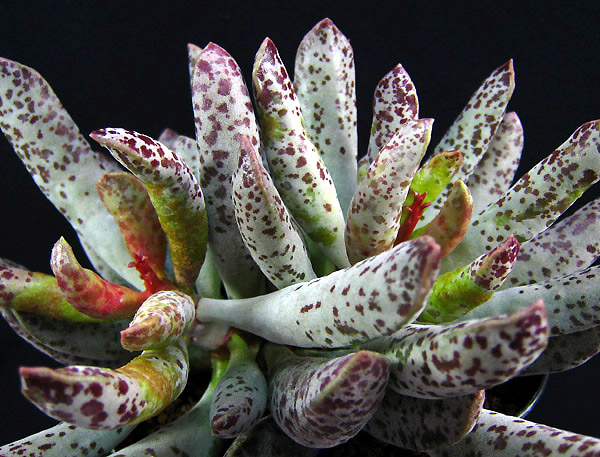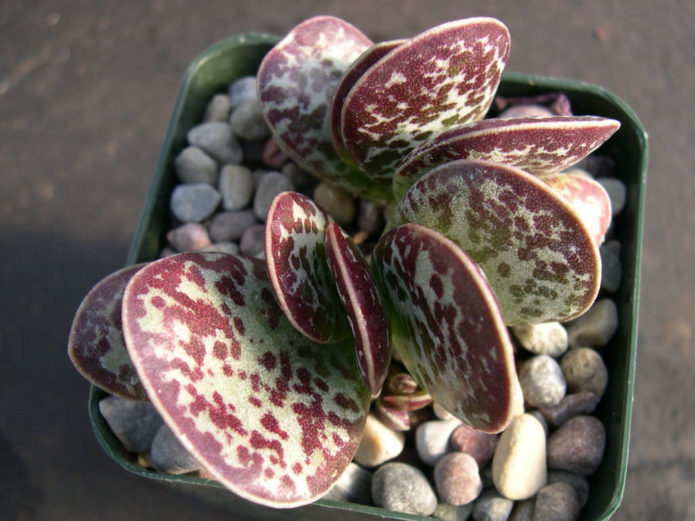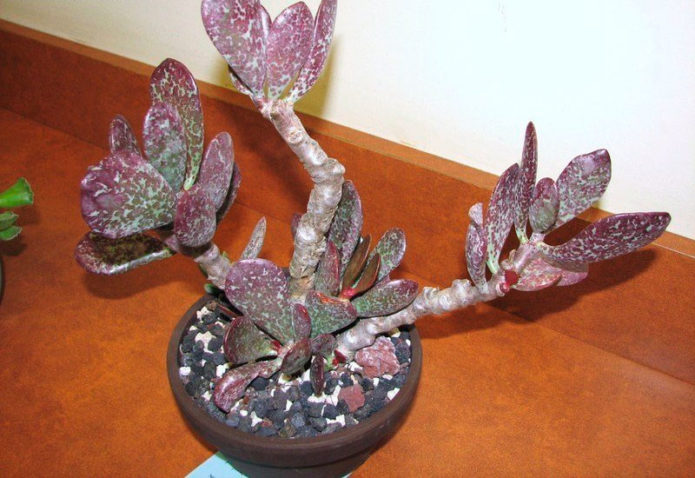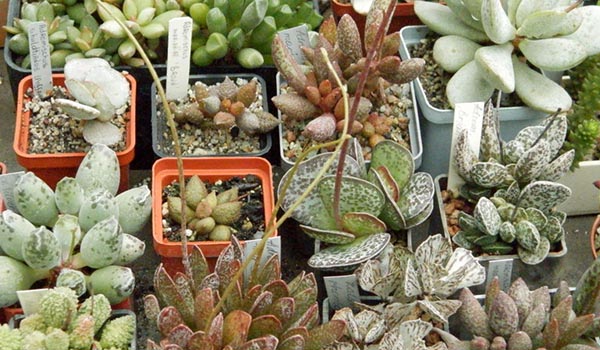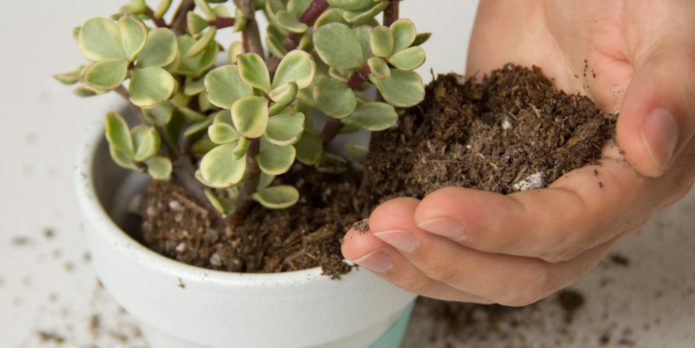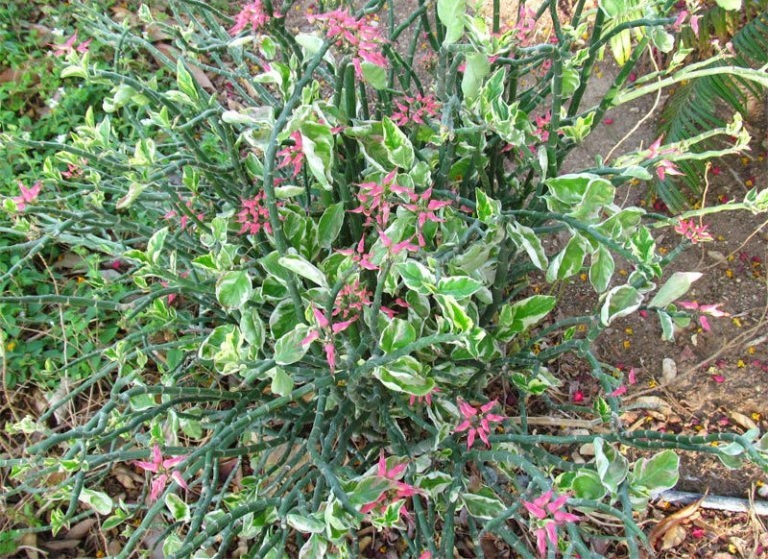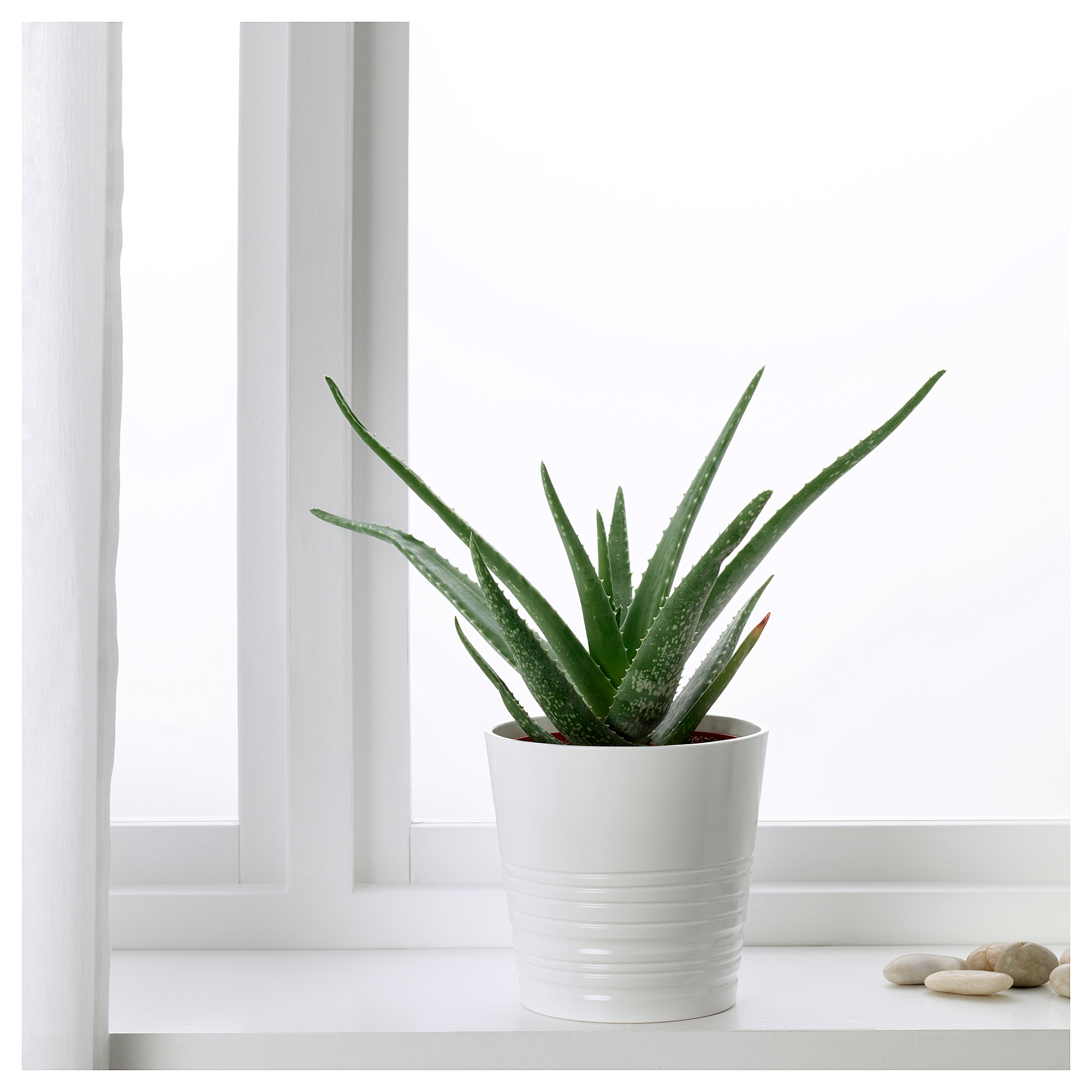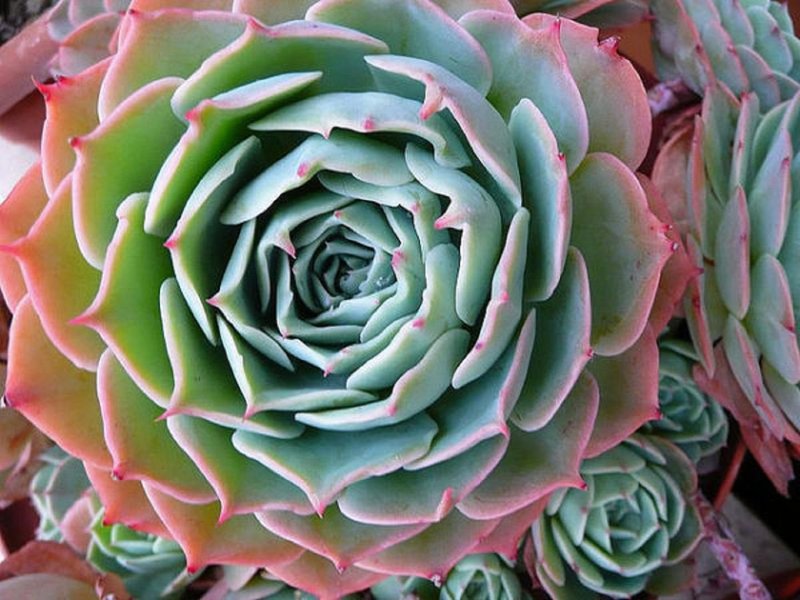Adromiscus is a succulent from the genus of the same name, belonging to the Tolstyankov family. This South African plant is actively cultivated at home. Its decorative effect is due to its unusual shape leaves, entirely covered with spots. Their tone becomes more saturated in bright light. Adromiscus blooms are rare and impressive. The plant is unpretentious in care, which is another plus.
Content
What's so interesting about andromiscus?
Adromiscus is a herbaceous perennial of the semi-shrub type up to 15 cm high. The plant has a creeping root and a thick lodging stem, covered with terracotta-colored air roots. Through them, the succulent absorbs moisture and nutrients from the air. The root system of adromiscus consists of many fine hairs, therefore, they require careful handling during transplantation. Outwardly peculiar foliage grows from a short stem - round or triangular in shape, fleshy, monochromatic green or with dark blotches. The average width of a leaf plate is 5–6 cm with a thickness of 1 cm.
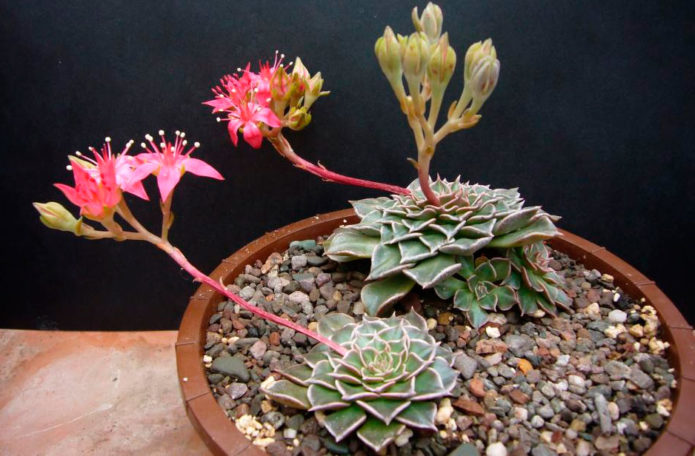
Adromiscus, when flowering, throws out a long arrow, at the top of which white-pink inflorescences bloom
Adromiscus blooms in summer with spectacular tubular inflorescences of a white-pink tone, grouped in spike-shaped brushes. They are attached to long and strong peduncles.
Common species and varieties with photos
In the natural environment, there are about 50 species of adromiscus, but only a few varieties are cultivated at home. Popular copies:
- Adromiscus cristatus (Adromischus cristatus) - is a stunted specimen up to 15 cm high. Their shoots are straight at first, and as they grow older, they lie on the ground. This is a plant with small pubescent leaves collected in rosettes. They have a wavy border along the edge. The flower blooms with white-green buds with a pink edging.
- Adromiscus Cooper (Adromischus cooperi) is a perennial with a branching creeping shoot. Rounded green leaves with a glossy surface are attached to it. They are wavy along the edge. The flowers of this representative are up to 1.5 cm long, red-green with a white or scarlet border.
- Adromischus poellnitzianus is a ten centimeter tall succulent with branching dark green shoots covered with brown hairs. The stems are convex at the base, and flattened above. During the flowering period, the plant shoots a forty-centimeter arrow with unattractive flowers at the top.
- Spotted Adromiscus (Adromischus maculatus) is a compact specimen about 10 cm tall. He has red spots on the surface of the leaf plates. And it blooms with creamy purple inflorescences.
- Three-pistil adromiscus (Adromischus trigynus) is a weakly branching undersized representative (no more than 10 cm) with rounded or slightly elongated small leaves up to 5 cm long and about 4 cm wide. On both sides they have brown specks. The buds of a succulent bloom of a similar color.
Table: optimal growth conditions for adromiscus depending on the season
| A period of time | Lighting | Humidity | Temperature | Location |
| Spring Summer | The plant prefers bright light, but with protection from the midday heat (otherwise burns on the leaves are likely) | During flowering, adromiscus needs high humidity. Dry air is preferred the rest of the time. | + 25-30 ºС (in the heat, regularly ventilate the room or place a flower near an open window) | Place a flower pot on the south, west or east windowsill |
| Autumn winter | + 7-15 ºС |
The soil for growing adromiscus should be rich in sand. It is allowed to use a ready-made substrate for succulents or cacti. You can prepare it yourself by mixing the following components:
- land from the garden - two parts;
- humus - two parts;
- coarse sand - three parts.
It will be useful to mix a handful of bone meal, ground eggshells and charcoal into the resulting soil mixture. Brick chips are used as drainage. A pot for planting plants is selected with an average volume, approximately 15 cm in diameter.
Care
Although this tropical succulent is unpretentious, certain care rules must be followed. These include:
- Watering - should be regular and moderate, without creating swampiness. It is important that the topsoil does not dry out completely. This applies to the spring-summer period. And in winter, the frequency of watering is reduced to 1 time per month. It is necessary to water the succulent exclusively with settled water at room temperature. Since adromiscus tends to accumulate moisture in the leaves, there is no need to spray the crown.
- Fertilizing - required throughout the growing season (March - September) at intervals of 1 time in 25-30 days. To do this, use factory-made mineral mixtures intended for cacti and succulents. From autumn to spring, they stop feeding the plant.
Adromiscus does not need pruning and shaping. Even after flowering, the buds should not be plucked for 2-3 weeks. Wait for them and the stems to dry. Only then are they cut off with a sharp instrument.
Planting and transplanting
A purchased plant is immediately transplanted into a larger pot and placed in a cool room with shading. The first 3-4 days the newcomer is not watered and is not greatly disturbed, which allows him to quickly adapt to a new place. Then the plant is rearranged on a well-lit windowsill and little by little watering begins.
Adromiscus transplant is carried out as the roots grow, when it becomes cramped in the old container... Usually, this procedure is resorted to once a year - in the spring (if this is necessary). They act as follows:
- 2–3 days before the planned transplant, the flower is completely stopped to water.
- A 5 cm thick drainage layer is poured into the bottom of the planting container. Small stones are suitable for this. Soil is poured over them.
- Carefully dig in the plant around the perimeter, adhering to the edge of the pot. This technique allows you to protect the roots from damage.
- The root ball is removed along with the earth, transferred to a new place and buried.At the same time, they try not to deeply deepen the stem.
After planting, adromiscus is not watered for the next few days.
Table: mistakes in care and how to fix them
| Problem manifestation | Causes | Correction methods |
| Yellowing and falling of old foliage | Normal phenomenon | Doesn't require any action |
| Intense yellowing and drying of leaves | Contact with water, which leads to burns | Shade the plant |
| The sheet plates are cracking | Lack of moisture | Normalize the irrigation regime |
| The shoots are strongly stretched and thinned, and spots disappear on the leaves | Insufficient lighting | Change the location of the flower |
Diseases and pests
In general, adromiscus rarely gets sick, but with excess moisture in the soil, root rot is possible... As a result of an intense putrefactive process, shoots and leaves are affected. If no emergency measures are taken, the plant dies. In a similar situation, they save it by propagating by cuttings. They are cut and planted in a new substrate, and the old bush is thrown away. When rot is present only on the leaf blades, the affected parts are cut off and the plant is sprayed with a fungicide.
With a small lesion area, you can proceed as follows:
- Dig up the adromiscus.
- Diseased roots are cut, and healthy areas are treated with any fungicidal preparation.
- The succulent is transplanted into a fresh substrate.
Pests are dangerous:
- aphid;
- mealybug;
- spider mite.
They are first removed from the bush by hand with a piece of cloth soaked in ethyl alcohol or soapy water. Then they resort to traditional methods of treatment - they spray the plant with garlic, onion or wormwood infusion. In especially severe cases, it is recommended to use insecticides: Actellik, Fitoverm, Neoron.
Reproduction
Adromiscus reproduces in several ways:
- leafy cuttings;
- seeds;
- dividing the bush.
Sheet
The most convenient time to implement this method is spring. In this way, it is possible to obtain a new plant while maintaining the original varietal characteristics.
Breeding technology:
- A healthy mother bush is selected and the thickest leaves are cut from it.
- They are removed in the dark and cool for 3-4 hours so that the sections are windy.
- Then the cuttings are planted in a substrate for cacti or mixed independently from vermiculite, peat and river sand in equal proportions. Deepen the sheets by 2 cm.
- Cover the container with plastic wrap and place it in a warm place protected from direct sunlight.
Further care consists in daily moistening of the soil and airing the cuttings. As soon as the first leaves appear on them, the protection is removed. Full rooting occurs within 3.5-4 weeks.
Video: nuances of leaf propagation of succulents
Seeds
Seed propagation is the most time consuming and time consuming... Only experienced florists use it.
Sequence of steps:
- The soil is poured into the prepared container and leveled.
- Seeds are evenly distributed from above and lightly sprinkled with sand.
- Cover the seedlings with glass or polyethylene, making holes in it for ventilation.
The optimum temperature in the germination room is + 20–23 ° C. The first shoots appear in 12-14 days. When the plants grow up and get stronger, they are transplanted into separate pots.
When choosing a seed propagation method, you should not expect flowering in the next 2 years.
By dividing the bush
This option is productive if implemented during the vegetative growth of the succulent. Since you have to disturb the root system of the plant, they do it in compliance with sterility. Why the tool is pre-disinfected. This is due to the tendency of the plant to be affected by root rot at the slightest ingress of pathogenic bacteria through the sections.
The procedure takes place in the following sequence:
- A part of the root is cut off with a knife.
- It is dried in the open air or powdered with charcoal.
- A prepared root is planted in fertile and loose soil and covered with earth.
The roots are systematically watered with warm settled water, trying not to create stagnation. Good illumination is required for successful germination, so it is recommended to install the container closer to the window.
The rare bloom of adromiscus is fully compensated by decorative foliage. Such a plant in the house will become an original decoration and will fit into any interior. And when you combine several succulents in a flowerpot, a very peculiar composition comes out that will surely attract the attention of others.
